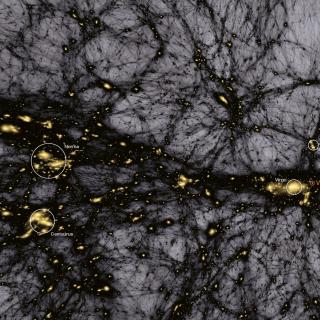Bibcode
Angulo, Raul E.; Sodré, Laerte; Dupke, Renato; Ederoclite, Alessandro; Alcaniz, Jailson; Vázquez Ramió, Héctor; Varela, Jesús; Moles, Mariano; Marín-Franch, Antonio; López-Sanjuan, Carlos; Hernández-Monteagudo, Carlos; Cenarro, Javier; Cristóbal-Hornillos, David; Daflon, Simone; Jiménez-Esteban, Fran; Cruz, Patricia; Galindo-Guil, F. J.; Coelho, Paula; Fan, Zhou; Liu, Jifeng; Hong, Jihye; Gu, Hongrui; Lee, Young Sun; Yuan, Haibo; Xiao, Kai; Beers, Timothy C.; Huang, Yang
Referencia bibliográfica
The Astrophysical Journal
Fecha de publicación:
10
2024
Revista
Número de citas
9
Número de citas referidas
6
Descripción
We present a catalog of stellar parameters (effective temperature T eff, surface gravity , age, and metallicity [Fe/H]) and elemental-abundance ratios ([C/Fe], [Mg/Fe], and [α/Fe]) for some five million stars (4.5 million dwarfs and 0.5 million giant stars) in the Milky Way, based on stellar colors from the Javalambre Photometric Local Universe Survey (J-PLUS) DR3 and Gaia EDR3. These estimates are obtained through the construction of a large spectroscopic training set with parameters and abundances adjusted to uniform scales, and trained with a kernel principal component analysis. Owing to the seven narrow/medium-band filters employed by J-PLUS, we obtain precisions in the abundance estimates that are as good as or better than those derived from medium-resolution spectroscopy for stars covering a wide range of the parameter space: 0.10–0.20 dex for [Fe/H] and [C/Fe], and 0.05 dex for [Mg/Fe] and [α/Fe]. Moreover, systematic errors due to the influence of molecular carbon bands on previous photometric-metallicity estimates (which only included two narrow/medium-band blue filters) have now been removed, resulting in photometric-metallicity estimates down to [Fe/H] ∼ ‑4.0, with typical uncertainties of 0.40 dex and 0.25 dex for dwarfs and giants, respectively. This large photometric sample should prove useful for the exploration of the assembly and chemical-evolution history of our Galaxy.
Proyectos relacionados

Cosmología con Trazadores de la Estructura a Gran Escala del Universo
El Fondo Cósmico de Microondas (FCM) contiene la información estadística de las semillas primigenias que han dado lugar a la formación de todas las estructuras en el Universo. Su contrapartida natural en el Universo local es la distribución de las galaxias que surgen como resultado del crecimiento gravitatorio de aquellas fluctuaciones de densidad
FRANCISCO SHU
KITAURA JOYANES